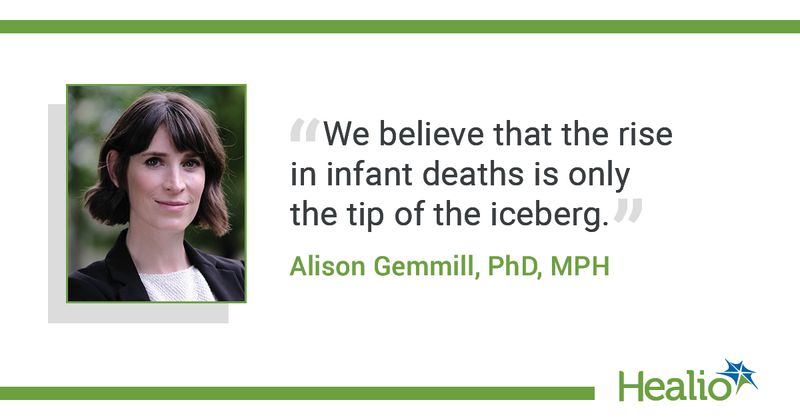Texas ban on abortion in early pregnancy associated with rise in infant deaths
Key takeaways:
- Texas Senate Bill 8 banned abortions after embryonic cardiac activity.
- There was a nearly 13% increase in infant deaths after the bill was implemented.
There was a nearly 13% increase infant deaths in Texas after the state implemented a ban on abortion in early pregnancy in 2021, according to research published in JAMA Pediatrics.
Texas Senate Bill 8 (SB8) took effect in September 2021, banning abortions after embryonic cardiac activity, with no exemptions for congenital anomalies.

“There have been previous studies that show an association between abortion restrictions in states that are hostile to abortion and increased infant mortality rates,” Alison Gemmill, PhD, MPH, a demographer and perinatal epidemiologist at the Johns Hopkins Bloomberg School of Public Health, told Healio. “Here, we had the opportunity to study the causal impact of one of the most restrictive abortion policies on infant deaths to shed light on this important question.”
Gemmill and colleagues began by using simple descriptive analyses to compare patterns of infant mortality in Texas to the rest of the United States.
“Even with these less rigorous methods, we were seeing suggestive evidence that something different was going on in Texas,” Gemmill said.
They next used a quasi-experimental study design to estimate unexpected changes in infant mortality that likely resulted from the policy.
“We do this by estimating what would have happened in Texas if the policy did not take effect and compare these hypothetical estimates to what we actually observed,” Gemmill said. “Our hypothetical Texas estimates were derived from pre-policy patterns in infant mortality in Texas and other states, as well as other demographic characteristics in each state.”
From 2018 to 2022, the researchers found that there were 10,351 infant deaths in Texas. Between 2021 and 2022, infant deaths in the state rose from 1,985 to 2,240, corresponding to a 12.9% increase, whereas the rest of the U.S. experienced a 1.8% increase.
In the researchers’ counterfactual analysis, which used data from Texas and eligible comparison states, there was an excess of 216 infant deaths (95% CI, 122 to 554) from March to December 2022, or a 12.7% increase above expectation. (The researchers treated babies born in March 2022 as the first cohort exposed to SB8.)
Descriptive statistics by cause of death showed that infant deaths attributable to congenital anomalies in 2022 increased for Texas (22.9% increase) but not the rest of the U.S. (3.1% decrease)
“These findings are particularly relevant given the recent Dobbs v. Jackson Women’s Health Organization U.S. Supreme Court decision and subsequent rollbacks of reproductive rights in many U.S. states,” the authors wrote.
Based on prior research, Gemmill said they expected that they might detect an increase in infant deaths after the Texas law went into effect.
“What surprised us was the increase in congenital anomalies that occurred in Texas but not the rest of the U.S.,” Gemmill said. “This finding suggests that one important way that highly restrictive abortion policies might lead to more infant deaths is because birthing people no longer have the option to legally terminate congenital anomalies, especially those that are highly incompatible with life, if they are detected.”
Given these findings, Gemmill said, health care providers should be prepared for an increase in complex medical cases, including conditions that require extensive medical intervention.
‘Multiple structural barriers’
“Additionally, they should advocate for comprehensive prenatal care and counseling to support affected families, and work toward policies that prioritize the health and well-being of both the birthing individuals and their infants,” Gemmill said.
In an accompanying editorial, Ghazaleh Moayedi, DO, MPH, and Aketch Osamba, MPH of the Dallas-based Pegasus Health Justice Center, and Atsuko Koyama, MD, MPH, of Camelback Family Planning in Phoenix, said they agreed with the authors “that the most important finding of this study is the increase in infant and neonatal mortality in Texas after the passage of SB8,” but disagreed that the findings were unexpected.
“It is known that limiting access to comprehensive reproductive health care, including abortion, disproportionately affects communities that are systematically marginalized and oppressed,” they wrote. “Pregnant people already facing multiple structural barriers to accessing health care, who may be unable to travel long distances, find child care, or take time off of work, can therefore be forced to continue pregnancies against their will under abortion bans.”
‘Tip of the iceberg’
Gemmill said future research could study whether other types of infant complications also increased in this time.
“We believe that the rise in infant deaths is only the tip of the iceberg,” Gemmill said. “Researchers should [also] study the stories and experiences of those adversely affected by abortion restrictions, including individuals who were denied the option to terminate in the event of a fetal complication, leading unnecessary trauma.”
References:
Gemmill A, et al. JAMA Pediatr. 2024;doi:10.1001/jamapediatrics.2024.0885.
Moayedi G, et al. JAMA Pediatr. 2024;doi:10.1001/jamapediatrics.2024.1792.
